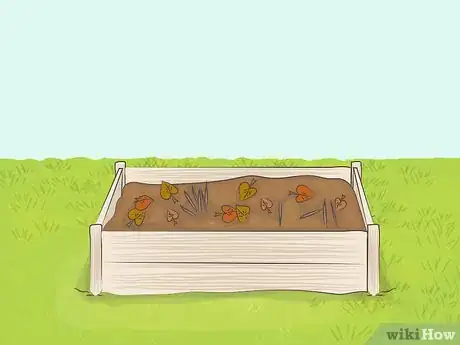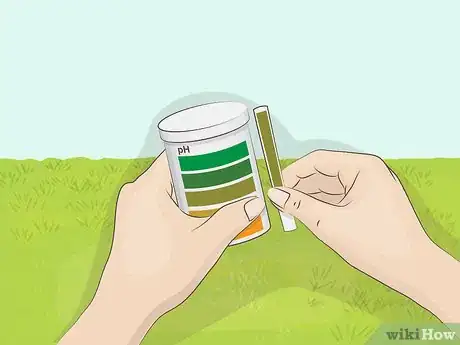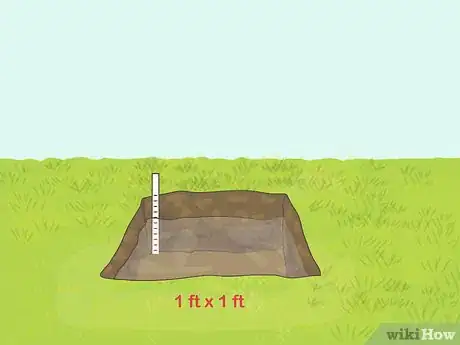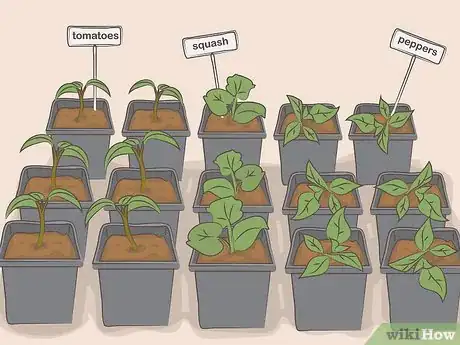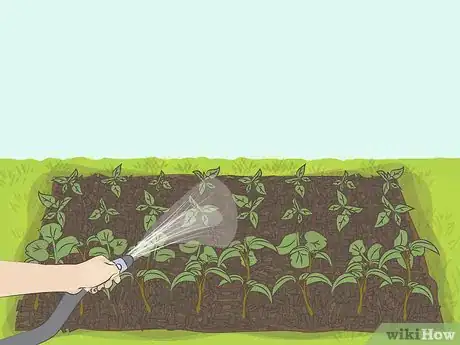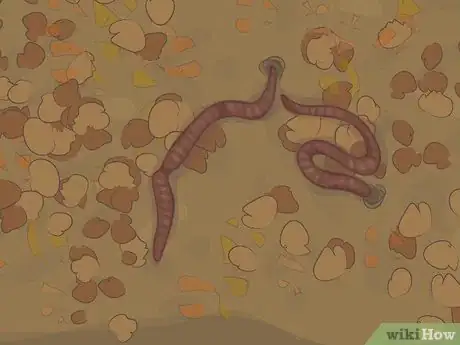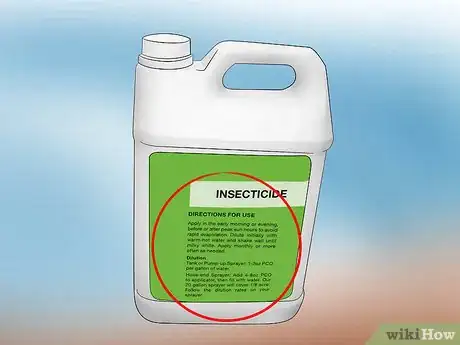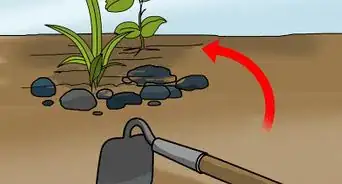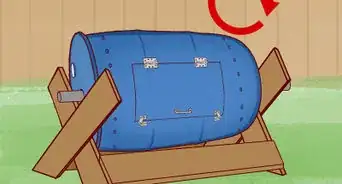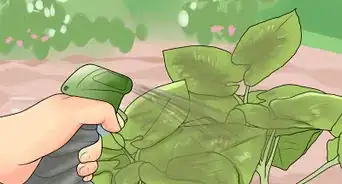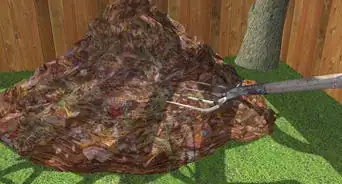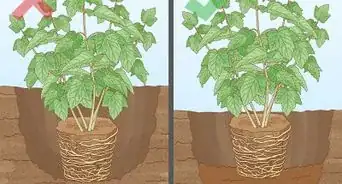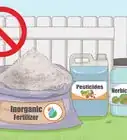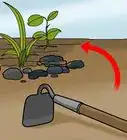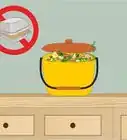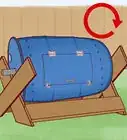This article was co-authored by Ben Barkan. Ben Barkan is a Garden and Landscape Designer and the Owner and Founder of HomeHarvest LLC, an edible landscapes and construction business based in Boston, Massachusetts. Ben has over 12 years of experience working with organic gardening and specializes in designing and building beautiful landscapes with custom construction and creative plant integration. He is a Certified Permaculture Designer, is licensed Construction Supervisor in Massachusetts, and is a Licensed Home Improvement Contractor. He holds an associates degree in Sustainable Agriculture from the University of Massachusetts Amherst.
There are 15 references cited in this article, which can be found at the bottom of the page.
wikiHow marks an article as reader-approved once it receives enough positive feedback. In this case, 93% of readers who voted found the article helpful, earning it our reader-approved status.
This article has been viewed 137,610 times.
Even if you've never gardened before, you can start your own organic garden to grow flowers, fruits, or vegetables. We'll help you get started, from choosing your site to helping your plants thrive.
Steps
Creating Your Garden Site
-
1Get started early. Get a jump on your gardening effort at any time of year by choosing a site for the garden, buying containers for a container garden, planting seedlings, building garden boxes, and making compost for your garden.
-
2Choose a small site for your organic garden. Think small, especially at first. Find a spot in your yard that gets at least 6 hours of sun a day.[1] A well-maintained 4 ft × 4 ft (1.2 m × 1.2 m) garden can furnish all of the fresh vegetables that one person will eat.
- Even a window box or a few containers can be a starter garden.
Advertisement -
3Think about using your lawn as a garden. A pristine lawn is a lot of work and, depending on your climate, may require a lot of fertilizer and water to keep green. It's also a mono-culture that is difficult to maintain. At the very least, consider letting clover and other plants in, and don't panic if a few weeds spring up. Consider planting something besides lawn or making your lawn smaller, especially in arid climates.
-
4Consider a container garden. Try growing in pots, boxes, or buckets on a patio. Even growing herbs in one of your south-facing windows to garnish your favorite dishes and soups is great fun.[2]
- Even if you don’t have a sunny backyard or patio, you may be able to grow parsley, mints, garlic/green onions, chives, or even small tomatoes this way.
- 5 US gal (19 l) buckets can be easily converted to gardening containers by adding a layer of pebbles to the bottom and drilling 3 or 4 1⁄2 in (13 mm) holes on the bottom for drainage.[3]
Making Organic Soil
-
1Make a compost pile. Compost is the main ingredient for developing rich organic soil. You can use almost any kind of organic material to make compost that will enrich your soil, but the best things to start with are usually right there in your garden:[4]
- Fallen leaves
- Weeds (preferably before they go to seed)
- Grass clippings
- Old fruit and vegetable trimmings
- Don't use anything containing oil, fat, meat, grease, feces, dairy, or wood chips.[5]
-
2Test the pH of your soil. Test the pH of your soil by buying pH test strips from a garden store. Stir a handful of soil with lukewarm distilled water until it's the consistency of a milkshake, then dip the pH test strip in. Hold it there for 20-30 seconds, then compare the strip to the test kit's key.
- The pH (acidity versus alkalinity) of your soil should be somewhere between 5.5 to 7.0 for plants to thrive.[6]
- If your soil is too acidic (below 5.5), buy dolomite or quick lime to add to the soil, then retest.
- If your soil is too alkaline (above 7.0), add more organic matter, like peat moss or compost, then test the soil again.
-
3Measure your soil's drainage. Dig a hole in your garden or container 1 ft × 1 ft (0.30 m × 0.30 m) wide. Fill the hole with water and wait 24 hours. Then, fill the hole with water again and measure how fast the water drops with a tape measure. The ideal rate is 2 in (5.1 cm) per hour.[7]
- Adding a few cups of compost or peat moss will help soil that drains too fast and soil that drains too slow.
- For a less scientific test, moisten your soil and grab a handful of it. The soil should hold together, but fall apart when you poke it with a finger. If your soil holds its shape or falls apart without a poke, add more organic matter (compost or peat moss) to improve its drainage.
-
4Add organic soil from your compost heap. The key to organic agriculture is great soil. Add as much organic material to your soil as you can, preferably from your compost heap. Soil that has been built up with plenty of organic matter is good for your garden for a lot of reasons:[8]
- It will nourish your plants without chemical fertilizers.
- It is easier to get shovels into—and weeds out of—enriched soil that isn't packed hard.
- It is softer, so plant roots can penetrate more easily and deeply.
- It will help water and air spend the right amount of time in contact with roots. Clay soils can be heavy and will stay wet for a long time. Sandy soils can drain water too quickly. Compost mitigates both conditions.
Planting and Maintaining Your Garden
-
1Choose plants for your organic garden. Think about what you like to eat and how often you want to eat it. Plants like tomatoes, peppers, and squash will keep producing all year long, while vegetables like carrots and corn will only produce once. Buy seedlings from a garden store or farmer's market.[9]
- Be sure to buy seedlings that haven't bloomed yet, and make sure to ask if they've been treated with chemicals. To be a true organic garden, your plants should be completely free of chemical fertilizers and pesticides.
-
2Plant your seedlings in full sun after the last frost. Plant seedlings into your organic, compost-rich soil and set them in areas where they'll receive full sun: at least 6 hours a day.[10]
- Plant thickly to prevent weed growth. Companion plantings can fill in spaces in vegetable gardens, too, and will help you make the most of a small space. Spaces that are planted thickly enough will discourage weeds from growing between plants that you want.
-
3Mulch areas around plants 2 in (5.1 cm) deep. Organic mulches, including bark, wood chips, and grass clippings, gradually break down and enrich the soil.[11]
- In the meantime, they control weeds, help to moderate soil temperatures, and slow evaporation, meaning that you can water less.
-
4Water your garden in the morning. Water in the morning, when the temperature is cool and there's less risk of evaporation, which will deprive your plants of water.
- Watering in the evening isn't ideal, as it keeps your plants wet overnight and encourages mildew. It's still preferable to watering in the middle of the day, though.[12]
-
5Weed your garden every few weeks. Regularly taking off the green portions of weeds will deprive them of the nourishment they need to continue growing. Weeds are any plant you don't want growing in an area, and may include invasive ornamental or productive plants, such as ivy and mint.[13]
- Use a hoe and keep it sharp. Try a Dutch hoe or scuffle hoe instead of a conventional gooseneck style hoe. Hoe each area frequently enough to keep green weeds down.
- Hand weed to remove the roots of perennial weeds that grow back. Also hand weed carefully around established plants, to avoid uprooting the plants you want.
- Try heat to control weeds in cracks, in the form of steam, a heat gun, boiling water, or even a small blowtorch, carefully applied.
-
6Attract helpful creatures by adding seeds, compost, or flowers. Many creatures can help your garden. Arrange the conditions of your garden to encourage them by:
-
7Avoid using chemicals in your garden. In order to be certified organic, a farm must abide by restrictions on the types of chemical insecticides and fertilizers they can use. While your home garden doesn't necessarily have to fit the criteria for an organic certification, you should try to focus on sustainability, and avoid using chemicals as much as possible.[17]
- Instead, you might opt for natural solutions to rid your garden of pests, like spraying them down with soap and water or neem oil.
Expert Q&A
-
QuestionHow do you start a garden from scratch for beginners?
 Ben BarkanBen Barkan is a Garden and Landscape Designer and the Owner and Founder of HomeHarvest LLC, an edible landscapes and construction business based in Boston, Massachusetts. Ben has over 12 years of experience working with organic gardening and specializes in designing and building beautiful landscapes with custom construction and creative plant integration. He is a Certified Permaculture Designer, is licensed Construction Supervisor in Massachusetts, and is a Licensed Home Improvement Contractor. He holds an associates degree in Sustainable Agriculture from the University of Massachusetts Amherst.
Ben BarkanBen Barkan is a Garden and Landscape Designer and the Owner and Founder of HomeHarvest LLC, an edible landscapes and construction business based in Boston, Massachusetts. Ben has over 12 years of experience working with organic gardening and specializes in designing and building beautiful landscapes with custom construction and creative plant integration. He is a Certified Permaculture Designer, is licensed Construction Supervisor in Massachusetts, and is a Licensed Home Improvement Contractor. He holds an associates degree in Sustainable Agriculture from the University of Massachusetts Amherst.
Garden & Landscape Designer Always research and double-check your gardening supplies before actually using them. Keep in mind that some products that are considered organic, like copper-based insecticides, can still be harmful for the environment. Be sure to research any product thoroughly before you use it in your garden.
Always research and double-check your gardening supplies before actually using them. Keep in mind that some products that are considered organic, like copper-based insecticides, can still be harmful for the environment. Be sure to research any product thoroughly before you use it in your garden. -
QuestionWhat vegetables are best to plant in a small garden?
 Maggie MoranMaggie Moran is a Professional Gardener in Pennsylvania.
Maggie MoranMaggie Moran is a Professional Gardener in Pennsylvania.
Home & Garden Specialist Some of the best plants for a small garden are Shallots, Kale, Lettuce, and Potatoes. There are several other types, as well.
Some of the best plants for a small garden are Shallots, Kale, Lettuce, and Potatoes. There are several other types, as well. -
QuestionWhat are the benefits of eating organic foods?
 Maggie MoranMaggie Moran is a Professional Gardener in Pennsylvania.
Maggie MoranMaggie Moran is a Professional Gardener in Pennsylvania.
Home & Garden Specialist They are healthier in that they don't have pesticides, and they are typically fresher as well since they don't contain preservatives.
They are healthier in that they don't have pesticides, and they are typically fresher as well since they don't contain preservatives.
Warnings
- Don't ever use bark mulch. It might look good, but it robs nitrogen from the soil as it rots, and will keep almost anything from growing well. It also attracts termites.⧼thumbs_response⧽
- Don't use the following for your compost pile, even if it's organic:
- No meat, flesh, bones or fat of any kind.
- No oil or grease.
- Avoid large amounts of watery fruits or vegetables such as tomatoes, oranges, cucumbers, melons, prepared foods, etc. (press, drain, to dry them some if you want to use them).
- No feces (poop) from any animal that eats meat, especially from dogs or cats (people too).
⧼thumbs_response⧽ - If you're going to grow edible vegetables, always test the soil for lead first.[18] Lead can leach out of weathered paint for many years and remain in the soil. Never plant fruit, veggies, herbs, or fruit-bearing trees in the soil next to your house if you know—or suspect—that it was painted with lead-based paint.[19]⧼thumbs_response⧽
References
- ↑ https://www.bhg.com/gardening/vegetable/vegetables/planning-your-first-vegetable-garden/
- ↑ https://www.goodhousekeeping.com/home/gardening/a20707074/container-gardening-tips/
- ↑ https://www.hobbyfarms.com/build-five-gallon-bucket-garden/
- ↑ https://www.goodhousekeeping.com/home/gardening/advice/g2104/organic-gardening-tips-460309/
- ↑ https://www.bhg.com/gardening/yard/compost/how-to-compost/
- ↑ http://www.cropnutrition.com/efu-soil-ph
- ↑ https://www.todayshomeowner.com/diy-soil-drainage-perk-test-for-your-yard/
- ↑ https://www.goodhousekeeping.com/home/gardening/advice/g2104/organic-gardening-tips-460309/
- ↑ https://www.goodhousekeeping.com/home/gardening/advice/g2104/organic-gardening-tips-460309/
- ↑ https://www.bhg.com/gardening/vegetable/vegetables/tips-for-growing-an-organic-vegetable-garden/
- ↑ http://www.finegardening.com/article/six-tips-for-effective-weed-control
- ↑ https://www.goodhousekeeping.com/home/gardening/advice/g2104/organic-gardening-tips-460309/
- ↑ https://www.networx.com/article/11-ways-to-control-weeds-without-chemica
- ↑ http://www.discoverwildlife.com/wildlife-gardens/how-attract-birds-your-garden
- ↑ https://www.planetnatural.com/worms-in-the-garden/
- ↑ https://www.naturallivingideas.com/beneficial-garden-insects/
- ↑ Ben Barkan. Garden & Landscape Designer. Expert Interview. 14 April 2020.
- ↑ Ben Barkan. Garden & Landscape Designer. Expert Interview. 14 April 2020.
- ↑ https://www.drsinatra.com/heart-healthy-diet-alert-whats-really-in-your-fruits-and-vegetables
About This Article
If you want to start an organic garden, begin by making a compost pile. You can compost leaves, fruit and vegetable scraps, weeds, and grass clippings to make a nutrient-rich soil for your garden. Once you have enough soil, choose a site in your yard that receives full sun or plant in containers and place them in a sunny spot. Then, get organic seedlings from your local nursery and plant them after the last frost. Add about 2 inches of mulch around your plants to help prevent weeds and water in your new plants. For tips from our Horticulturist reviewer on how to test the pH of your soil, keep reading.




